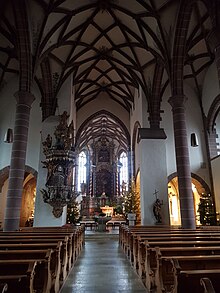St. Peter and Paul (Because of the City)
St. Peter and Paul is the Catholic town church in Weil der Stadt . Today's church was built at the end of the Swabian late Gothic.
History of the city and the church
The village was first mentioned in 1075 in a deed of donation to the Hirsau monastery . But it is also conceivable that the village was not founded in the High Middle Ages , but already at the time of the Merovingians . At that time the church was probably a fortified church . The settlement under the Staufers was expanded into a town because it was conveniently located at a river crossing and a road crossing. In the process, the village layout was lost. The streets of the new core city were laid out at right angles. After the collapse of the Hohenstaufen and a short interregnum under Rudolf von Habsburg, the city became an imperial city in 1275 . With the appointment of a pastor in 1295 the church, which was then only consecrated to St. Peter, and St. Paul only became a second patron saint after the middle of the 17th century , became part of the parish church . In the 14th and 15th centuries, Weil expanded its rights, but was unable to gain any significant territory. The Reformation could not prevail in Weil, the city and church remained Catholic. When the city was destroyed by French troops in 1648, the church burned down too. In 1802 the free imperial city came to Württemberg .
Building history
The oldest known remains of a sacred building , the foundation of an apse , lie under the sacristy . No other masonry of this building has been preserved. Between 1180 and 1220 work began on a new building, a three-aisled basilica without a transept . At the end of the aisles to the east, where the choir begins, two towers were built. The choir ended in a round apse, the aisles ended under the towers. Today's nave had almost the same dimensions as the late Gothic. The construction of this basilica took longer. Around 1370–80 a three-story rectangular tower was added to the west. The octagonal storey for the bell cage was only added later. The first changes to the basilica were made around 1460–70. A later phase of renovation began in 1492 and was largely completed in 1519 with the arching of the choir. It was like a new building. The nave, choir and sacristy were redesigned. The three towers and parts of the foundations were reused. After the fire in 1648, the church was restored from 1655. Inside, the vault of the nave was destroyed in the fire, a wooden flat ceiling that was painted. Repairs were made to the little damaged outer walls. In the 1860s, repair work could not be postponed. It was decided to completely renew the church. Joseph von Egle was commissioned with the implementation . The Gothic vault was roughly reconstructed in terms of height, vault section and rib structure . Another major renovation of the church took place in 1938–40. Extensive renovation work took place in 1978-89.
Building description
The nave of today's three-aisled hall church is covered with a gable roof. The buttresses of the nave were taken inside. The pilaster strips of the nave and the outer buttresses of the choir are decorated with pinnacles . Inside, the three-aisled nave of the basilica was redesigned in favor of a three-aisled hall. Chapels have been set up on the ground floor of the towers integrated into the nave . The nave and the choir were once separated by a rood screen. Remains are on the triumphal arch . A star vault spans the choir . The sacristy with a polygonal end, built to the north of the choir , also has a star vault.
Furnishing
The baroque dominates the furnishings . The high altar was completed in 1700 and placed in the choir. The pulpit installed in 1742 is a work of the Rococo . It is unknown whether the numerous late Gothic statues survived the fire of 1648 or come from secular churches.
In the north-west corner of the nave, Gothic epitaphs are reminiscent of patricians from the 15th to 17th centuries; on the exterior, they come from the Renaissance period . The baroque organ front from 1730 is decorated with angels, putti and a large coat of arms of the city. The organ with three manuals , pedal and 2368 pipes was rebuilt in 1968.
Web links
literature
- Felix Hammer: Catholic town church St. Peter and Paul Weil der Stadt. Schnell, Art Guide No. 965. Regensburg 2006
Coordinates: 48 ° 45 ' N , 8 ° 52' E

